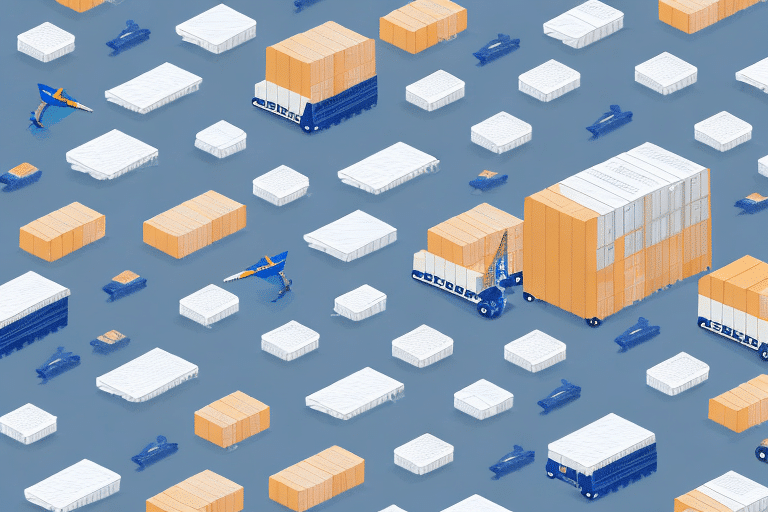How to Use UPS Worldship for International Shipping
If you're looking to expand your business internationally, shipping your products to customers around the world is essential. However, international shipping can be complex, with varying regulations, customs requirements, and service levels to navigate. UPS WorldShip is a comprehensive shipping software that helps businesses manage their international shipping needs efficiently and effectively. In this article, we'll explore how to use UPS WorldShip for international shipping, covering everything from the basics to troubleshooting common issues and managing your shipping costs. Let's get started.
Understanding the Basics of UPS WorldShip
Before diving into the complexities of international shipping, it's crucial to understand what UPS WorldShip is and how it functions. WorldShip is a shipping software that allows businesses to manage both domestic and international shipping needs from a single platform. It integrates seamlessly with your existing systems, enabling you to create shipping labels, generate customs documentation, and track packages in real-time. This powerful tool streamlines shipping processes, saving time and reducing costs.
One of the key benefits of UPS WorldShip is its ability to simplify the customs clearance process. With WorldShip, you can easily generate all necessary customs documentation, including commercial invoices and packing lists, and submit them electronically to customs authorities. This not only saves time but also reduces the risk of errors and delays during customs clearance.
In addition to shipping and customs capabilities, UPS WorldShip offers valuable reporting and analytics features. You can generate reports on shipping activity, including package volume, shipping costs, and delivery times. This data helps identify areas for improvement in your shipping processes and supports informed decision-making regarding your shipping strategy.
Preparing Your Shipment for International Shipping
Once you understand the basics of WorldShip, you can start preparing your shipments for international destinations. This involves several critical steps:
- Packaging and Labeling: Ensure your products are properly packaged and labeled according to international standards. The packaging should be durable enough to withstand the rigors of international transit, and labeling must include all necessary information, such as the recipient's name and address, product description, and relevant customs documentation. WorldShip can help you create shipping labels and customs documents efficiently.
- Regulatory Compliance: Research and comply with the import and export regulations of the destination country. This includes understanding restrictions or prohibitions on certain products and obtaining any required permits or licenses. Non-compliance can result in delays, fines, or even seizure of your shipment.
- Insurance: Consider purchasing insurance for your international shipments to protect against potential damage or loss during transit. WorldShip offers insurance options, allowing you to choose the coverage level that best suits your needs.
Choosing the Right Service Level and Shipping Options
Selecting the appropriate service level and shipping options is crucial to ensuring your package arrives on time and within budget. WorldShip provides a variety of options for both domestic and international shipping, including:
- Service Levels: Choose from express, standard, and economy services based on the package size, weight, destination, and desired delivery timeframe.
- Additional Services: Options such as insurance or signature confirmation can provide extra security and protection for your packages.
Be mindful that different service levels can significantly impact shipping costs. For instance, express services may be more expensive but necessary for urgent deliveries, while standard or economy services can be more cost-effective for less time-sensitive shipments. It's advisable to compare available service levels and shipping options to ensure you receive the best value for your money.
Navigating the WorldShip Interface
The WorldShip interface may seem complex initially, but with practice, you can navigate and customize it to suit your needs. Key features of the interface include:
- Menus and Tabs: Manage shipments, create labels, and track packages in real-time using the intuitive menus and tabs.
- Customization: Tailor the interface to display information that matters most to you, such as shipping history or delivery status.
- Support Resources: Access training materials and support resources to help you master WorldShip quickly.
Entering Shipping Information and Creating Labels
WorldShip streamlines the shipping process by allowing you to enter all necessary shipping information in one place. This includes the recipient's address, product details, and customs documentation. Once entered, WorldShip automatically generates shipping labels and customs documents, which you can print directly from the software or save for future use. Additionally, WorldShip offers batch processing for creating multiple labels simultaneously, enhancing efficiency.
Troubleshooting Common Errors in WorldShip
Like any software, WorldShip can present errors or issues. Common problems include incorrect address information, incomplete customs documentation, or service-level restrictions in certain countries. To address these issues, WorldShip provides a range of support resources, including online guides, live chat, and phone support. Regular software updates and patches are also released to resolve any bugs or issues.
Managing Shipment Tracking and Delivery
After your package is shipped, WorldShip allows you to manage tracking and delivery efficiently. Features include:
- Real-Time Tracking: Monitor the progress of your package from origin to destination for both domestic and international shipments.
- Delivery Notifications: Receive alerts and notifications to stay informed about the delivery status of your packages.
- Reporting Tools: Analyze shipping activity over time to identify trends and make data-driven decisions.
Tips for Streamlining Your International Shipping Process
While WorldShip facilitates international shipping, implementing the following tips can optimize your shipping process for maximum efficiency and cost-effectiveness:
- Specialized Packaging: Use packaging designed specifically for international shipping to minimize the risk of damage during transit.
- Customs Research: Thoroughly research the customs regulations of your target countries to ensure smooth and efficient customs clearance.
- Batch Processing: Utilize batch processing features in WorldShip to create shipping labels for multiple packages simultaneously.
- Customs Broker: Consider employing a customs broker for complex shipments to navigate the customs process effectively.
Best Practices for Packaging and Labeling Your Shipments
Proper packaging and labeling are vital for ensuring that your packages arrive safely and on time. Follow these best practices:
- Durable Packaging: Select packaging materials that are sturdy and designed for international shipments.
- Protective Cushioning: Use appropriate cushioning materials to protect your products during transit.
- Comprehensive Labels: Ensure all necessary information is included on the shipping label, such as the recipient's name and address, product description, and relevant customs documentation.
- Clear Labeling: Use clear, readable fonts and securely attach labels to the package to ensure they remain intact during shipping.
Understanding Customs Regulations and Documentation Requirements
International shipping involves navigating complex customs regulations and documentation, which vary by country. As a shipper, it's your responsibility to ensure that your package complies with all requirements to facilitate smooth customs clearance. Keep the following in mind:
- Regulation Research: Investigate the customs regulations of your destination countries thoroughly.
- Accurate Documentation: Include all necessary customs documents, such as commercial invoices, certificates of origin, and export declarations.
- Consistency: Ensure that the information on customs documents matches the shipping label and the products inside the package.
- Accurate Valuation: Declare the accurate value of the products to avoid customs delays or penalties.
How to Track Your Packages with UPS WorldShip
UPS WorldShip offers robust tracking capabilities for both domestic and international shipments, allowing you to monitor your packages from start to finish. To track a package:
- Enter the tracking number in the UPS Tracking Tool on the UPS website or within the WorldShip interface.
- Sign up for shipment alerts and notifications to receive updates on your package's delivery status.
Best Practices for Customer Service with International Shipping
Providing excellent customer service is crucial for maintaining customer satisfaction and loyalty, especially with international shipping. Implement the following best practices:
- Clear Communication: Inform customers promptly about shipping status, delivery times, and any applicable customs duties or fees.
- Tracking and Notifications: Offer tracking information and delivery notifications to keep customers informed about their shipments.
- Educational Resources: Provide information about customs regulations and documentation requirements to help customers understand the shipping process.
- Responsive Support: Address customer inquiries and concerns promptly and professionally to enhance their experience.
Using UPS WorldShip to Manage Returns and Exchanges
UPS WorldShip can also streamline the management of returns and exchanges, making the process more efficient for both you and your customers. Features include:
- Return Labels: Create return labels easily within WorldShip to facilitate the return process.
- Reverse Logistics: Manage the reverse logistics process efficiently, ensuring smooth returns and exchanges.
- Reporting Tools: Track the volume and frequency of returns to identify trends and areas for improvement, ultimately reducing return rates over time.
How to Manage Your Shipping Costs with UPS WorldShip
Managing shipping costs is essential for maintaining profit margins and growing your business. UPS WorldShip offers various tools and resources to help you minimize shipping expenses:
- Service-Level Optimization: Utilize tools that help you select the most cost-effective service levels for your shipments.
- Discounted Rates: Take advantage of discounted shipping rates available for high-volume shippers.
- Cost Tracking and Reporting: Monitor shipping costs over time using tracking and reporting tools to identify cost-saving opportunities.
- Expert Advice: Access shipping experts through UPS who can offer guidance on managing shipping costs more effectively.
By leveraging these features, you can optimize your shipping strategy to balance cost and efficiency effectively.
Conclusion
Using UPS WorldShip for international shipping can significantly streamline your shipping processes and facilitate the expansion of your business globally. By understanding the basics of WorldShip, selecting the appropriate service levels and shipping options, and adhering to best practices for packaging, labeling, and customs compliance, you can ensure that your packages arrive on time and in good condition. Additionally, utilizing WorldShip's tracking and reporting tools allows you to monitor and manage your shipping activity, identify areas for improvement, and reduce shipping costs over time. With the right tools and strategies, mastering international shipping with UPS WorldShip is well within your reach.






















